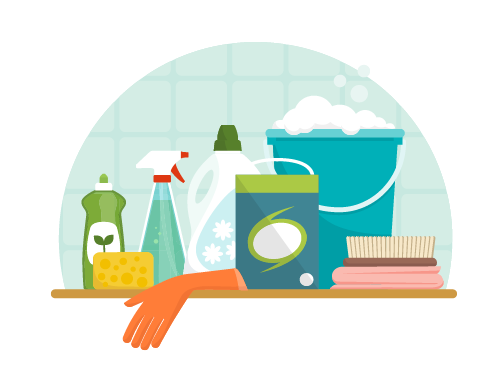Master Everyday Cleaning Techniques: Exactly How to Correctly Scrub the Surfaces and Maintain a Clutter-Free Home
Master Everyday Cleaning Techniques: Exactly How to Correctly Scrub the Surfaces and Maintain a Clutter-Free Home
Blog Article
Comprehending the Need for Completely Decontaminating and Sterilizing Frequently Touched Surface Areas in High-Traffic Locations
In the world of public wellness and safety and security, the meticulous sanitation and sanitization of regularly touched surface areas in high-traffic locations stand as vital actions in stopping the spread of damaging virus. By exploring the various elements of surface area disinfection, from the dangers connected with ignoring cleaning methods to the efficient techniques that can be utilized, a more clear understanding emerges of the vital role these techniques play in safeguarding public health.
Importance of Surface Sanitation
Stressing the extensive disinfection of high-traffic surfaces is essential in preserving a hygienic atmosphere and protecting against the spread of damaging pathogens. High-touch surfaces such as door handles, light switches, lift buttons, and kitchen counters work as breeding grounds for infections and microorganisms. Routine disinfection of these surface areas is crucial to lower the risk of contamination and transmission of health problems.
By applying a robust sanitation procedure, services and institutions can create a safer setting for employees, site visitors, and customers. Proper surface sanitation not only reduces the spread of contagious diseases however likewise imparts confidence in the tidiness and safety and security of the properties. This aggressive strategy demonstrates a commitment to health and health, which is particularly crucial in high-traffic areas where the possibility of direct exposure to pathogens is enhanced.
Furthermore, surface sanitation plays an important role in overall infection control techniques. Combined with hand hygiene methods, putting on masks, and keeping physical distancing, comprehensive disinfection of high-touch surface areas develops a thorough protection against the transmission of damaging microbes. Prioritizing surface disinfection is an essential component of an all natural method to health and wellness and security in shared spaces.
Threats of Disregarding Cleansing Practices
Neglecting detailed sanitation of high-traffic surfaces significantly heightens the risk of viral and microbial contamination, presenting a major risk to the health and wellness of individuals frequenting these spaces. Failing to apply proper cleansing techniques can bring about the accumulation and spread of unsafe virus, consisting of infections and germs, on often touched surfaces such as doorknobs, handrails, lift switches, and counter tops.

In addition, overlooking the importance of extensive cleaning not just jeopardizes the well-being of individuals however likewise weakens initiatives to maintain a clean and hygienic atmosphere. It is vital to recognize the importance of appropriate disinfection protocols in stopping the spread of infections and securing public health and wellness.
Reliable Sanitation Methods
To keep ideal tidiness and minimize the danger of contamination on high-traffic surface areas, utilizing efficient sanitation approaches is essential. One of the most effective and typical disinfection approaches is making use of chemical anti-bacterials. These items can vary in toughness and make-up, with some targeting certain microorganisms like infections or bacteria. defrosted and cleaned every few months It is vital to adhere to the producer's directions for proper dilution, contact time, and air flow when making use of chemical anti-bacterials to ensure their efficiency - Clear Out Any Clutter.
One more effective technique is making use of UV-C light. UV-C light has actually been revealed to be reliable in eliminating a broad variety of bacteria by interrupting their DNA framework, therefore preventing them from replicating. It is essential to make use of UV-C light effectively, making certain that the proper intensity and direct exposure time are used to attain the wanted disinfection outcomes.
Additionally, employing vapor cleansing as a sanitation method can be extremely effective, particularly on surface areas that are heat-resistant. Steam can permeate permeable surface areas and eliminate germs, viruses, and various other virus effectively. When using vapor cleaning, it is vital to guarantee that the surface area reaches the needed temperature level for a sufficient quantity of time to guarantee appropriate disinfection.
Influence On Public Wellness
The upkeep of high requirements of sanitation and disinfection on high-traffic surface areas plays a crucial role in guarding public wellness. Regularly touched surfaces in areas with high tramp, such as doorknobs, hand rails, lift switches, and bathroom centers, serve as breeding premises for damaging pathogens.
In high-traffic locations like airports, schools, hospitals, and public transportation systems, the influence of rigorous sanitation steps can not be downplayed. Focusing on the sanitization of regularly touched surface areas is an aggressive method to promoting public health and enhancing the safety and security of individuals in common spaces.
Applying Routine Cleaning Up Protocols
Immediately instituting and adhering to a regular schedule of cleaning procedures is extremely important for keeping the tidiness and security of high-traffic surface areas. Normal cleaning methods are essential in protecting against the buildup of bacteria and pathogens on regularly touched surface areas, particularly in areas with high foot traffic. By implementing a methodical strategy to cleansing, companies can properly minimize the risk of disease transmission and develop a healthier atmosphere for employees, clients, and the general public.
To establish an efficient cleaning routine, it is critical to recognize high-traffic areas that require constant interest. These areas may include doorknobs, handrails, lift switches, toilet facilities, and common equipment. Implementing a routine cleaning program that targets these surface areas multiple times a day can significantly reduce the spread of unsafe microorganisms and infections.
Moreover, using suitable cleaning agents and anti-bacterials is crucial to making certain that surfaces are completely sterilized. Routine training of cleaning up team on appropriate cleaning strategies and the relevance of adherence to the cleansing timetable is additionally vital in keeping a hygienic environment. By focusing on regular cleaning methods, organizations can promote the wellness and well-being of individuals that communicate with these high-traffic surface areas.

Final Thought
In final thought, it is important to prioritize thorough sanitation and sanitization of often touched surface areas in high-traffic areas to prevent the spread of harmful microorganisms and keep public health and wellness. It is necessary to identify the relevance of preserving clean surface areas in high-traffic areas to make sure the health of the community.
In the world of public health and wellness and security, the careful sanitation and sanitization of often touched surfaces in high-traffic areas stand as critical procedures in avoiding the spread of damaging pathogens. By discovering the different elements of surface disinfection, from the threats linked with disregarding cleansing methods to the reliable methods that can be employed, a more clear understanding arises of the crucial duty these practices play in guarding public wellness.In addition, employing vapor cleaning as a sanitation technique can be highly efficient, particularly on surface areas that are heat-resistant. When using vapor cleaning, it is vital to make certain that the surface gets to the called for temperature level for an adequate amount of time to guarantee appropriate sanitation.
In conclusion, it is essential to focus on comprehensive sanitation and sanitization of regularly touched surfaces in high-traffic locations to protect against the spread of damaging microorganisms and keep public wellness.
Report this page